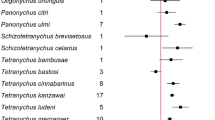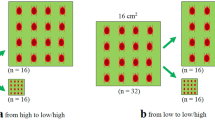Abstract
Although temperature is the most important environmental factor regulating arthropod development and reproduction, its influence on sex allocation in haplodiploid arthropods remains largely unexplored. We investigated under laboratory conditions how maternal age and temperature mediate offspring sex ratio of the spider mite Tetranychus mcdanieli (Acari: Tetranychidae). Over nine temperature regimes, female-biased sex ratios were consistently observed, varying from 57 to 87% among progeny produced over lifetime. Spider mite sex ratio was affected by maternal age: more male progeny were produced at both the beginning and the end of the female lifespan, yielding a dome shaped curvilinear relationship. This pattern of variation with age probably results from constraints on using sperm at young ages and sperm depletion or viability at older ages. We found a significant curvilinear relationship between temperature and sex ratio. The proportion of female offspring was lowest at intermediate temperatures and highest at extreme temperatures. We suggest that increased female-biased sex ratio at extreme temperatures is an evolutionary response of spider mites to deteriorating habitats as, in the Tetranychidae, females have better capacities than males to disperse and survive under harsh conditions.


Similar content being viewed by others
References
Agresti A (1990) Categorical data analysis. Wiley, New York
Carey JR, Bradley JW (1982) Developmental rates, vital schedules, sex ratios, and life tables for Tetranychus urticae, T. turkestani and T. pacificus (Acarina: Tetranychidae) on cotton. Acarology 23:333–345
Charnov EL (1979) The genetical evolution of patterns of sexuality: Darwinian fitness. Am Nat 113:465–480
Charnov EL (1982) The theory of sex allocation. Princeton University Press, Princeton, N.J.
Feiertag-Koppen CCC, Pijnacker LP (1985) Oogenesis. In: Helle W, Sabelis MW (eds) Spider mites, their biology, natural enemies and control. Elsevier, Amsterdam, pp 117–127
Griffing B (1982) A theory of natural selection incorporating interactions among individuals. X. Use of groups consisting of a mating pair together with haploid and diploid caste members. J Theor Biol 95:199–223
Hamilton A, Botsford LW, Carey JR (1986) Demographic examination of sex ratio in the two-spotted spider mite, Tetranychus urticae. Entomol Exp Appl 41:147–151
Hamilton WD (1967) Extraordinary sex ratios. Science 156: 477–488
Helle W (1967) Fertilization in the two-spotted spider mite (Tetranychus Urticae: Acari). Entomol Exp Appl 10:103–110
Helle W, Pijnacker PL (1985) Parthenogenesis, chromosomes and sex . In: Helle W, Sabelis MW (eds) Spider mites, their biology, natural enemies and control. Elsevier, Amsterdam, pp 129–139
Horn HS, Rubenstein D I (1984) Behavioural adaptations and life history. In: Krebs JR, Davies NB (eds) Behavioural ecology: an evolutionary approach. Blackwell, London, pp 279–298
King BH (1987) Offspring sex ratios in parasitoid wasps. Q Rev Biol 62:367–396
Krainacker DA, Carey JR (1988) Maternal heterogeneity in primary sex-ratio of three tetranychid mites. Exp Appl Acarol 5:151–162
Krainacker DA, Carey JR (1989) Reproductive limits and heterogeneity of male twospotted spider mites. Entomol Exp Appl 50:209–214
Lewontin RC (1965) Selection for colonizing ability. In: Baker HG, Stebbins GL (eds) The genetics of colonizing species. Academic Press, San Diego, Calif. pp 79–94
Margolies DC, Wrench DL (1996) Temperature-induced changes in spider mite fitness: offsetting effects of development time, fecundity, and sex ratio. Entomol Exp Appl 78:111–118
Moraes GJ de, McMurtry JA (1987) Effect of temperature and sperm supply on the reproductive potential of Tetranychus evansii (Acari: Tetranychidae). Exp Appl Acarol 3:95–107
Overmeer WPJ (1972) Notes on the mating behaviour and sex ratio of Tetranychus urticae (Koch) (Acarius: Tetranychidae). Entomol Ber 32:240–244
Pianka ER (1988) Evolutionary ecology, 4th edn. Harper & Row, New York
Potter DA (1978) Functional sex ratio in the carmine spider mite. Ann Entomol Soc Am 71:218–222
Roy M, Brodeur J, Cloutier C (1999) Seasonal abundance of spider mites and their predators on red raspberry in Quebec. Environ Entomol 28:735–747
Roy M, Brodeur J, Cloutier C (2002) Relationship between temperature and developmental rate of Stethorus punctillum (Coleoptera: Coccinellidae) and its prey Tetranychus mcdanieli (Acarina: Tetranychidae). Environ Entomol 31:177–187
Roy M, Brodeur J, Cloutier C (2003) Effect of temperature on intrinsic rates of natural increase (rm) of a coccinellid and its spider mite prey. BioControl 48:57–72
Sabelis MW (1985) Reproductive strategies. In: Helle W, Sabelis MW (eds) Spider mites, their biology, natural enemies and control. Elsevier, Amsterdam, pp 237–278
Sabelis MW (1991) Life history evolution of spider mites. In: Schuster R, Murphy PW (eds) The Acari. Reproduction, development and life-history strategies. Chapman & Hall, New York, pp 23–49
Sabelis MW, Janssen A (1996) Evolution of life-history patterns in the Phytoseiidae. In: Houck MA (ed) Mites: ecological and evolutionary analyses of life-history patterns. Chapman & Hall, New York, pp 70–98
SAS Institute (1999) SAS/STAT User's Guide, Version 8. SAS Institute, Cary, N.C.
Shih CT (1979) The influence of age of female Tetranychus kanzawai on sex ratio and life cycle of its progeny. In: Rodriguez JG (ed) Recent advances in acarology, vol 1. Academic Press, San Diego, pp 511–517
Stoks R (2001) Male-biased sex ratios in mature damselfly populations: real or artefact? Ecol Entomol 26: 181–187
Veerman A (1985) Diapause. In: Helle W, Sabelis MW (eds) Spider mites, their biology, natural enemies and control Elsevier, Amsterdam, pp 279–316
Waage JF (1986) Family planning in parasitoids: Adaptive patterns of progeny and sex allocation. In: Waage JK, Greathead D. (eds) Insect parasitoids. Academic Press, New York, pp 63–95
Wellington WG, Johnson DL, Lactin DJ (1999) Weather and insects. In: Huffaker CB, Guttierez AP (eds) Ecological entomology. Wiley, New York, pp 313–353
Werren JH, Charnov EL (1972) Facultative sex ratios and population dynamics. Nature 272: 349–350
Wrensch DL (1993) Evolutionary flexibility through haploid males or how chances favors the prepared genome. In: Wrensch DL, Ebbert MA (eds) Evolution and diversity of sex ratio in insects and mites. Chapman & Hall, New York, pp 118–149
Wrensch DL, Young SSY (1975) Effects of quality of resource and fertilization status on some fitness traits in the two-spotted spider mite, Tetranychus urticae Koch. Oecologia 18:259–267
Wrensch DL, Young SSY (1978) Effects of density and host quality on rate of development, survirvorship, and sex ratio in the carmine spider mite. Environ Entomol 7:499–501
Young SSY, Wrensch DL, Kongchuensin M (1986) Control of sex ratio by female spider mites. Entomol Exp Appl 40:50–60
Acknowledgements
We thank I.C.W. Hardy and J.A. Rosenheim for valuable comments on various aspects of this manuscript; G. Daigle for his help in the statistical analyses; and M.C. Pépin and L. Laverdière for technical assistance. This work was supported by the Quebec Ministry of Agriculture, Fisheries and Food.
Author information
Authors and Affiliations
Corresponding author
Rights and permissions
About this article
Cite this article
Roy, M., Brodeur, J. & Cloutier, C. Temperature and sex allocation in a spider mite. Oecologia 135, 322–326 (2003). https://doi.org/10.1007/s00442-002-1160-9
Received:
Accepted:
Published:
Issue Date:
DOI: https://doi.org/10.1007/s00442-002-1160-9




